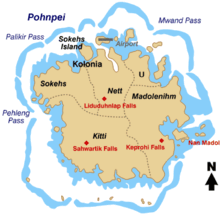Koloniais a coastal town and the capital ofPohnpei Statein theFederated States of Micronesia(FSM). It's not to be confused with the far smallerColonia,the capital of theState of Yap.It was also the former FSM capital before being replaced byPalikirin 1989, located nearby to the southwest in the municipality ofSokehs.It has 6,074 people.





Description
editKolonia Town is located in the north central section ofPohnpei Island.It was formerly part ofNettmunicipality but has been a separate municipality since May 1965. The population of the town was 6,074 (2010 Census).[1]It is the largest population center on Pohnpei and the commercial hub of the island. The land area of Kolonia amounts to 1.5 km2,with a large number of buildings lying just outside the town limits. The official languages are Pohnpeian and English. Mercedarian Missionaries speak Spanish.
History
editKolonia's history is deeply marked by Pohnpei's multiple foreign occupiers, and evidence of their former presence is found throughout the town and island. Traditionally, Pohnpei's power center was inMadolenihmw,on the southeastern part of the island. The area now known as Kolonia was calledMesenieng,which means "face of the wind" or "headwind."Spainfirst built the town in 1887 as an administrative and military capital and named itSantiago de la Ascensión.A fort, from which ruins known as the Spanish Wall remain, was built to protect the colonial government and garrison.
In 1899, as a consequence of the Spanish–American War,Germanypurchased Pohnpei from Spain along with the rest of theCaroline Islandsand established district offices in Kolonia. Roads and wharves were built and buildings erected (a church bell tower and cemetery[2]remain), but the town stayed relatively small as few German or other foreign settlers arrived to live on the island. Kolonia and northern Pohnpei were devastated by atyphoonin 1905.
Japanoccupied Pohnpei in the first weeks ofWorld War Ias well as other German islands north of the equator. Unlike previous occupiers, the Japanese brought thousands of settlers to Micronesia, who outnumbered the indigenous population on some islands. These settlers, most of whom wereOkinawans,vastly expanded the infrastructure in addition to establishing settlements elsewhere on Pohnpei. Visitors to Kolonia in the 1930s reported that they were able to walk the length of Namiki Street (now Kaselelhie Street) under shopkeepers' canopies without getting wet in the rain.
DuringWorld War II,much of Kolonia was destroyed as some 118 tons ofAmericanbombs, 600 incendiaries and naval artillery targeted the town and island installations. Pohnpei was bypassed during the amphibious island hopping campaigns, but rusting wrecks of Japanese military equipment, downed airplanes and bunkers are still visible throughout the island. The town was rebuilt and expanded during theUS Navyand later theUS Department of the Interioradministrations. TheFederated States of MicronesiaConstitutional Referendum and theCompact of Free Associationled to independence in 1986.
Today, construction in various parts of town continues and all of Kolonia's primary and secondary streets are paved and street signs erected. Kolonia Town boasts Pohnpei State government offices, public and private schools, grocery stores, restaurants, bars, hotels and houses of worship of various religious denominations.[3]
Pohnpei International Airport(IATAcode: PNI) is located on the small island Deketik and is connected to Kolonia via the Deketik causeway.
The United States,Australia,Chinaand Japan maintain embassies in Kolonia, although the Federation's capital is now at Palikir. A number of foreign volunteer groups operate in Kolonia, including thePeace Corps,the Japan Overseas Cooperation Volunteers (JOCVorJICA),WorldTeach,theRed Cross,theJesuit Volunteer Corps,the Spanish Mercedarian Missionaries ofBerriz,the Conservation Society of Pohnpei (CSP), and Pacific Missionary Aviation (PMA).
Sights
editTheCatholic Belltowerbuilt by the Germans/Spanish in 1909, theGerman Cemeteryfounded in 1910, theSpanish Walldating from 1887 and theJapanese Shrinebuilt in 1921 are worth a visit in Kolonia itself. The famous archaeological siteNan Madolis in the southeast of the island.
Climate
edit| Climate data for Kolonia | |||||||||||||
|---|---|---|---|---|---|---|---|---|---|---|---|---|---|
| Month | Jan | Feb | Mar | Apr | May | Jun | Jul | Aug | Sep | Oct | Nov | Dec | Year |
| Mean daily maximum °C (°F) | 29 (84) |
29 (84) |
29 (85) |
29 (85) |
29 (85) |
29 (85) |
30 (86) |
30 (86) |
30 (86) |
30 (86) |
29 (85) |
29 (84) |
29 (85) |
| Mean daily minimum °C (°F) | 26 (78) |
26 (78) |
26 (79) |
26 (78) |
26 (78) |
25 (77) |
24 (76) |
24 (76) |
24 (76) |
24 (76) |
25 (77) |
26 (78) |
25 (77) |
| Averageprecipitationmm (inches) | 300 (11.9) |
260 (10.3) |
350 (13.9) |
450 (17.8) |
500 (19.7) |
430 (17.1) |
450 (17.6) |
420 (16.5) |
400 (15.8) |
420 (16.5) |
410 (16.3) |
430 (17) |
4,840 (190.7) |
| Source: Weatherbase[4] | |||||||||||||
Education
editPohnpei State Department of Educationoperates public schools:
- Pohnpei Island Central School(former Pacific Island Central School or PICS)[5]
- Kolonia Elementary School[6]
- Ohmine Elementary School[6]
Private schools:
- Calvary Christian Academy[5]
- Seventh-day Adventist High School[5]
- Our Lady of Mercy Catholic High Schoolin Kolonia[7]
Lidorkini Museumwas located in Kolonia until its closure in 2012.[8]
See also
editReferences
edit- ^"2010 FSM Census of Population & Housing: Pohnpei State".2010. Archived fromthe original(PDF)on 2012-03-22.Retrieved2013-10-17.
- ^U.S. Geological Survey Geographic Names Information System: German Cemetery
- ^Panholzer, Thomas; Mauricio, Rufino (2003).Place Names of Pohnpei Island: Including And (Ant) and Pakin Atolls.Honolulu, Hawai'i: Bess Press.ISBN9781573061667.
- ^ "Weatherbase: Historical Weather for Kolonia, Federated States of Micronesia".Weatherbase. 2011. Retrieved on November 24, 2011.
- ^abc"Higher Education in the Federated States of MicronesiaArchived2017-10-14 at theWayback Machine."Embassy of the Federated States of Micronesia Washington DC. Retrieved on February 23, 2018.
- ^ab"Pohnpei SchoolsArchived2018-07-26 at theWayback Machine."Pohnpei State Department of Education. Retrieved on February 23, 2018.
- ^"Come Visit UsArchived2018-02-23 at theWayback Machine."Our Lady of Mercy Catholic High School.Retrieved on February 23, 2018. "The school is located on the Catholic Mission in Kolonia near the Spanish Wall"
- ^"Green Travel Guide to Micronesia - How to Visit Sustainably".ecofriendlytravels.com.Retrieved2021-07-16.